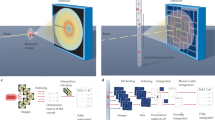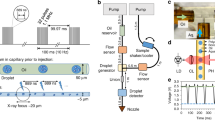Abstract
X-ray free electron laser (X-FEL)-based serial femtosecond crystallography is an emerging method with potential to rapidly advance the challenging field of membrane protein structural biology. Here we recorded interpretable diffraction data from micrometer-sized lipidic sponge phase crystals of the Blastochloris viridis photosynthetic reaction center delivered into an X-FEL beam using a sponge phase micro-jet.
This is a preview of subscription content, access via your institution
Access options
Subscribe to this journal
Receive 12 print issues and online access
$259.00 per year
only $21.58 per issue
Buy this article
- Purchase on Springer Link
- Instant access to full article PDF
Prices may be subject to local taxes which are calculated during checkout



Similar content being viewed by others
References
Chapman, H.N. et al. Nature 470, 73–77 (2011).
DePonte, D.P. et al. J. Phys. D Appl. Phys. 41, 195505 (2008).
Jordan, P. et al. Nature 411, 909–917 (2001).
Landau, E.M. & Rosenbusch, J.P. Proc. Natl. Acad. Sci. USA 93, 14532–14535 (1996).
Caffrey, M. Annu. Rev. Biophys. 38, 29–51 (2009).
Johansson, L.C., Wöhri, A.B., Katona, G., Engstrom, S. & Neutze, R. Curr. Opin. Struct. Biol. 19, 372–378 (2009).
Rosenbaum, D.M., Rasmussen, S.G. & Kobilka, B.K. Nature 459, 356–363 (2009).
Wadsten, P. et al. J. Mol. Biol. 364, 44–53 (2006).
Wöhri, A.B. et al. Structure 16, 1003–1009 (2008).
Wöhri, A.B. et al. Biochemistry 48, 9831–9838 (2009).
Emma, P. et al. Nat. Photonics 4, 641–647 (2010).
Bozek, J.D. Eur. Phys. J. Spec. Top. 169, 129–132 (2009).
Strüder, L. et al. Nucl. Instrum. Methods Phys. Res. A 614, 483–496 (2010).
Kirian, R.A. et al. Opt. Express 18, 5713–5723 (2010).
Kirian, R.A. et al. Acta Crystallogr. A 67, 131–140 (2011).
Duisenberg, A.J.M. J. Appl. Cryst. 25, 92–96 (1992).
Leslie, A.G.W. Acta Crystallogr. D. Biol. Crystallogr. 62, 48–57 (2006).
McCoy, A.J. et al. J. Appl. Cryst. 40, 658–674 (2007).
Murshudov, G.N., Vagin, A.A. & Dodson, E.J. Acta Crystallogr. D53, 240–255 (1997).
Brunger, A.T. et al. Acta Crystallogr. D Biol. Crystallogr. 54, 905–921 (1998).
Brunger, A.T. Nat. Protoc. 2, 2728–2733 (2007).
Acknowledgements
Experiments were carried out at the LCLS, a national user facility operated by Stanford University on behalf of the US Department of Energy, Office of Basic Energy Sciences. We acknowledge financial support from the Swedish Research Council (Vetenskapsrådet), the Swedish Foundation for International Cooperation in Research and Higher Education, Stiftelsen Olle Engkvist Byggmästare, the Max Planck Society for funding the development and operation of the CAMP instrument, the US National Science Foundation grant MCB 0919195, the US Department of Energy Office of Basic Energy Sciences through the Photon Ultrafast Laser Science and Engineering Center Institute at the SLAC National Accelerator Laboratory and the Energy Frontier Research Center for Bio-Inspired Solar Fuel Production (award DE-SC0001016), the Hamburg Ministry of Science and Research and Joachim Herz Stiftung as part of the Hamburg Initiative for Excellence in Research and the Hamburg School for Structure and Dynamics in Infection, US National Science Foundation (awards 0417142 and MCB-1021557), US National Institutes of Health (awards 1R01GM095583-01 and 1U54GM094625-01), the Deutsche Forschungsgemeinschaft Cluster of Excellence at the Munich Center for Advanced Photonics, Center for Biophotonics Science and Technology at the University of California (cooperative agreement PHY 0120999).
Author information
Authors and Affiliations
Contributions
L.C.J., R.N., H.N.C., J.C.H.S. and P.F. conceived the experiment, which was designed with A.B., R.A.K., J.C.H.S., D.P.D., U.W., R.B.D., M.J.B., D.S., I.S., S.M. and J.H. S.W.E., R.H., D.R., A.R., L.F., N.K., P.H., B.R., B.E., A.H., C.R., G.W., L.S., G.H., H.G., J.U., I.S., H.S., M.B., H.H., L.G. and H.G. designed and set up the CAMP instrument and/or developed and operated the pnCCD detectors. C.B. and J.D.B. set up and aligned the beamline; L.C.J. and D.A. grew sponge phase crystals; U.W., R.B.D., J.C.H.S., D.P.D., R.L.S. and L.L. designed and operated the injector; H.N.C., A.B., A.A., J.S., D.P.D., U.W., R.B.D., S.B., M.J.B., L.G., J.H., M.M.S., N.T., J.A., S.S. and J.C.H.S. developed diffraction instrumentation; L.C.J., D.A., T.A.W., D.P.D., U.W., R.B.D., R.L.S., L.L., E.M., J.D., K.N., M.L., A.A., M.B., A.B., M.J.B., C.B., J.D.B., C.C., R.C., N.C., T.E., H.F., P.F., C.Y.H., M.S.H., S.K., R.A.K., F.R.N.C.M., A.V.M., I.S., M.M.S., R.G.S., F.S., N.T., X.W., C.W., H.N.C., J.C.H.S. and R.N. collected data; L.C.J., D.A., T.A.W., G.K., W.Y.W. and K.N. analyzed the diffraction data using software developed by J.C.H.S., T.A.W., R.A.K., A.B. and H.N.C.; L.C.J. and R.N. wrote the paper with discussion and improvements from all authors.
Corresponding author
Ethics declarations
Competing interests
The authors declare no competing financial interests.
Supplementary information
Supplementary Text and Figures
Supplementary Figures 1–10, Supplementary Tables 1–4, Supplementary Note (PDF 5467 kb)
Rights and permissions
About this article
Cite this article
Johansson, L., Arnlund, D., White, T. et al. Lipidic phase membrane protein serial femtosecond crystallography. Nat Methods 9, 263–265 (2012). https://doi.org/10.1038/nmeth.1867
Received:
Accepted:
Published:
Issue Date:
DOI: https://doi.org/10.1038/nmeth.1867
This article is cited by
-
A host dTMP-bound structure of T4 phage dCMP hydroxymethylase mutant using an X-ray free electron laser
Scientific Reports (2019)
-
Hydroxyethyl cellulose matrix applied to serial crystallography
Scientific Reports (2017)
-
Oil-free hyaluronic acid matrix for serial femtosecond crystallography
Scientific Reports (2016)



